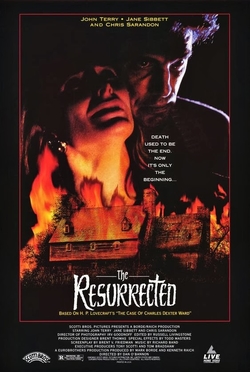Plot
Claire Ward hires private investigator John March to look into the increasingly bizarre activities of her husband Charles Dexter Ward, an esteemed Rhode Island chemical engineer. Through a series of conversations with John, Claire reveals Charles's recent unexplained isolation in their carriage house, his sudden uncovering of his family history, and their visitation to an abandoned ancestral farmhouse near Pawtuxet where he found a painting of a man named Joseph Curwen, to whom he bears an uncanny resemblance. Since these events, Charles has purchased and moved into the farmhouse, leaving Claire without explanation.
Upon investigating, John finds that numerous deliveries are made to the farmhouse, and inquires about them to Charles, who is evasive; Charles explains that he is undertaking routine chemical tests using animal cadavers. Shortly after, an elderly man in a neighboring home is found brutally murdered, only a few remnants of his bones left in the house. Police assume he was attacked and eaten by an animal, but John is skeptical. Claire and John go to visit Charles together, and find him pallid and speaking with an archaic affect. They attempt to extract an explanation from Charles, but he simply tells them he is on "the edge of greatness", and that in six weeks' time, they will understand.
Claire agrees to have Charles committed to a hospital. Doctors find his metabolism to be inexplicably high, triggering ravenous hunger, and attribute his change in demeanor to hormonal issues; however, they are unable to explain his craving for blood and raw meat. Meanwhile, John uncovers a diary in the carriage house from Ezra Ward, Charles's fifth-great grandfather, dated 1771. The diary explains how Ezra had an affair with Joseph's wife Eliza, and that Joseph had been practicing necromancy in catacombs he constructed on his property. After a flood penetrated the catacombs, the townspeople discovered a grotesquely malformed creature in the river, which they burned alive. The diary ends leading up to the townspeople's raid of the Curwen house, and Eliza's admission to Ezra that she was pregnant with Joseph's child; Claire, John, and John's assistant Lonnie surmise that Charles's biological great-grandfather was actually Joseph, not Ezra.
John and Lonnie decide to search for catacombs on the farmhouse property with Claire. They uncover the entrance in the house's basement, and inside the catacombs find a laboratory and half-grown creatures in wells; Claire also discovers Charles's briefcase. They attempt to flee but are attacked, and Lonnie is killed by one of the creatures. John leaves a bomb in the catacombs, and he and an injured Claire escape with the briefcase before the house detonates. John takes Claire to the hospital where she is sedated, and the doctor informs him she is pregnant.
John goes to visit Charles in the psychiatric institution, and confronts him with the briefcase, which he discovered filled with human bones. He accuses Charles of in fact being the 250-year-old Joseph Curwen, who successfully found a way to conquer death through his necromantic experiments. Joseph admits his identity, and confesses that the bones in the suitcase are those of Charles, whom Joseph killed after Charles raised him from the dead. He explains his plan to regain his health and eventually be discharged from the hospital, after which he can impersonate Charles. Joseph attempts to cannibalize John, but John pours the restorative potion from the laboratory over Charles's bones. Charles's skeleton reanimates, and begins to tear the flesh off Joseph, before the two disappear in a cosmic explosion.
This page is based on this
Wikipedia article Text is available under the
CC BY-SA 4.0 license; additional terms may apply.
Images, videos and audio are available under their respective licenses.
